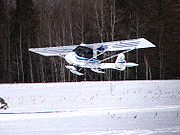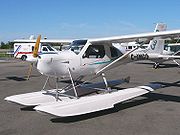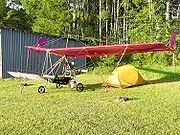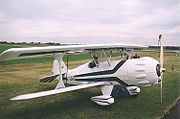.gif)
Ultralight aircraft (Canada)
Encyclopedia





Canadian Aviation Regulations
The Canadian Aviation Regulations are the rules that govern civil aviation in Canada.-Establishment:The CARs became law on October 10, 1996 replacing the former Air Regulations and Air Navigation Orders. The authority for the establishment of the CARs is the Aeronautics Act...
define two types of ultralight aircraft: basic ultra-light aeroplane (BULA), and advanced ultra-light aeroplane (AULA).
Canadian definition of ultra-light
Regulation of ultra-light aircraft in Canada is covered by the Canadian Aviation RegulationsCanadian Aviation Regulations
The Canadian Aviation Regulations are the rules that govern civil aviation in Canada.-Establishment:The CARs became law on October 10, 1996 replacing the former Air Regulations and Air Navigation Orders. The authority for the establishment of the CARs is the Aeronautics Act...
. An earlier definition of "ultra-light aeroplane", effective October 10, 1996, meant
- a single-seat aeroplane that has a launch weight of 165 kgKilogramThe kilogram or kilogramme , also known as the kilo, is the base unit of mass in the International System of Units and is defined as being equal to the mass of the International Prototype Kilogram , which is almost exactly equal to the mass of one liter of water...
(364 poundsPound (mass)The pound or pound-mass is a unit of mass used in the Imperial, United States customary and other systems of measurement...
) or less, and a wing area, expressed in square metres, of not less than the launch weight in kilograms minus 15, divided by 10, and in no case less than 10 m², - a two-seat instructional aeroplane that has a launch weight of 195 kg (430 pounds) or less, and a wing area, expressed in square metres, of not less than 10 m² and a wing loadingWing loadingIn aerodynamics, wing loading is the loaded weight of the aircraft divided by the area of the wing. The faster an aircraft flies, the more lift is produced by each unit area of wing, so a smaller wing can carry the same weight in level flight, operating at a higher wing loading. Correspondingly,...
of not more than 25 kg/m² (5.12 lb/ft²), the wing loading being calculated using the launch weight plus the occupant weight of 80 kg (176 pounds) per person, or - an advanced ultra-light aeroplane;
On June 1, 2003, the definition was amended to state that an "ultra-light aeroplane" means either an advanced ultra-light aeroplane or a basic ultra-light aeroplane.
Basic ultra-light aeroplane
On July 6, 1956 the Department of Transport first issued new requirements for ultralight aircraft, a category that was eventually renamed "Amateur-built aircraft", leaving Canada without an ultralight category. The basic ultralight category was established as a new cateory in 1982 to fill this gap. Regulation of ultralight aircraft in Canada is covered by the Canadian Aviation RegulationsCanadian Aviation Regulations
The Canadian Aviation Regulations are the rules that govern civil aviation in Canada.-Establishment:The CARs became law on October 10, 1996 replacing the former Air Regulations and Air Navigation Orders. The authority for the establishment of the CARs is the Aeronautics Act...
, which defines a "basic ultra-light aeroplane" as:
an aeroplane having no more than two seats, designed and manufactured to have:
- a maximum take-off weightMaximum Take-Off WeightThe Maximum Takeoff Weight or Maximum Takeoff Mass of an aircraft is the maximum weight at which the pilot of the aircraft is allowed to attempt to take off, due to structural or other limits. The analogous term for rockets is Gross Lift-Off Mass, or GLOW...
not exceeding 544 kg (1,200 pounds), and - a stall speed in the landing configuration (VS0V speedsIn aviation, V-speeds are standard terms used to define airspeeds important or useful to the operation of all aircraft including fixed-wing aircraft, gliders, autogiros, helicopters, and dirigibles...
) of 39 knots (45 mph) indicated airspeed, or less, at the maximum take-off weight;
Advanced ultra-light aeroplane
According to Canadian Aviation Regulations, Part I, Subpart 1, an "advanced ultra-light aeroplane" means an aeroplane that has a type design that is in compliance with the standards specified in the manual entitled Design Standards for Advanced Ultra-light Aeroplanes (DS10141).An advanced ultra-light aeroplane is an aeroplane which:
- Is propeller driven;
- Is designed to carry a maximum of two persons, including the pilot;
- Has a maximum take-off mass, MTOmax or WTOmax, of:
- 350 kg (770 lb) for a single place aeroplane, or
- 560.0 kg (1232 lb) for a two place aeroplane;
- A maximum stalling speed in the landing configuration, VS0, at manufacturer's recommended maximum take-off mass (weight) not exceeding 72 km/h (20 m/s, 45 mph) (IAS); and
- Is limited to non-aerobatic operations. Non-aerobatic operations include:
- manoeuvres incident to normal flying
- stalls and spins (if approved for type);
- lazy eights, chandelles; and
- steep turns, in which the angle of bank is not more than 60º
The advanced ultra-light aeroplane (AULA) category is similar, but not identical, to the American light sport aircraft (LSA) category. Many aircraft are available as AULAs in Canada and LSAs in the United States.
Minimum useful load
Advanced ultra-light aeroplanes shall have a minimum useful load, MU or WU computed as follows:- For a single place aeroplane:
-
- MU = 80 + 0.3P, in kg; where P is the rated engine(s) power in kilowatts;
- MU = 175 + 0.5P, in lb; where P is the rated engine(s) power in brake horsepowerHorsepowerHorsepower is the name of several units of measurement of power. The most common definitions equal between 735.5 and 750 watts.Horsepower was originally defined to compare the output of steam engines with the power of draft horses in continuous operation. The unit was widely adopted to measure the...
(bhp).- For a two place aeroplane:
- MU = 160 + 0.3P, in kg; where P is the rated engine(s) power in kW;
- MU = 350 + 0.5P, in lb; where P is the rated engine(s) power in bhp).
Maximum empty mass (weight)
The maximum empty mass, MEmax, (WEmax) includes all operational equipment that is actually installed in the aeroplane. It includes the mass (weight) of the airframe, powerplant, required equipment, optional and specific equipment, fixed ballast, full engine coolant, hydraulic fluid, and the residual fuel and oil. Hence, the maximum empty mass (weight) = maximum take-off mass (weight) - minimum useful load.The registration marks for an advanced ultra-light aeroplane after 1997 begin with "C-Ixxx". Prior to that date they were C-Fxxx or C-Gxxx.
Operations
An ultra-light pilot permit, recreational pilot permit, private, commercial or airline transport aeroplane licence issued by Transport CanadaTransport Canada
Transport Canada is the department within the government of Canada which is responsible for developing regulations, policies and services of transportation in Canada. It is part of the Transportation, Infrastructure and Communities portfolio...
, is required in order for a person to operate an ultra-light aeroplane in Canada. Pilots holding a Recreational or higher license may carry a passenger in a two-seat advanced ultra-light aeroplane. Pilots with only an ultra-light permit or flying a basic ultra-light aeroplane may not carry a passenger.
Nomenclature
Officially this category of aircraft are known in Canada as Ultra-light Aeroplanes although in common use the American term Ultralight Airplanes is often used.External links
- Light Aircraft Manufacturers Association Of Canada
- Ultralight Pilots Association of Canada
- Ultralight Pilots Association of Canada - Review of Canadian Aircraft Categories
- Canadian Owners and Pilots Association - Aircraft in Canada - Ultralights
- Transport Canada Listing of Models Eligible to be Registered as Advanced Ultra-Light Aeroplanes (AULA)

